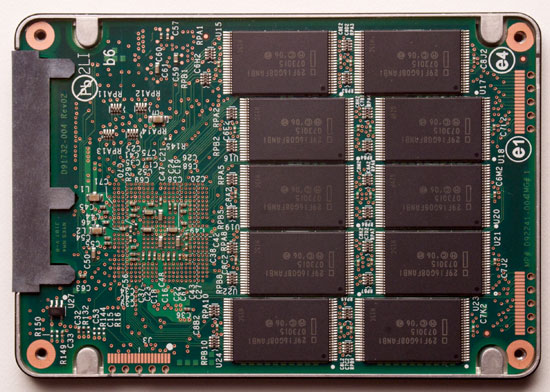Intel Reveals SSD Details at IDF 2008
by Anand Lal Shimpi on August 19, 2008 12:00 AM EST- Posted in
- Trade Shows
SSD: The Intel Way
Everyone and their mom is making SSDs these days, where does Intel see room for differentiation? Intel's SSD design attempts to be different in the three key areas that determine SSD performance: Flash, Firmware and Controller.
The Flash memory used by Intel's SSD is Intel's own SLC and MLC NAND Flash, you can see the Intel logos on the sample below:

The Flash itself shouldn't really be any faster than Samsung or any competitor's Flash, but it's an indication of why Intel wants to compete in this market: it's another use for Intel silicon. The Flash is Intel's own 50nm NAND Flash and Intel plans on allocating the majority of its Flash production for its SSDs.
The Firmware and Flash-to-SATA controller are both made by Intel, whereas most SSD makers use off the shelf components and FPGAs for their designs. Intel claims that its expertise in microprocessor and platform design allows for much higher levels of performance out of its SSDs. Intel also mentioned that despite recent quotes saying that Vista isn't optimized for SSD performance, that its controller/firmware design was done in such a way to minimize the need for OS-level optimizations. Intel wanted to make sure that today, without any OS changes, that the impact of its SSDs was "good".
The advantage isn't manifested only in peak performance, but also small file read/write performance which can cause many SSDs to really bog down. While our own performance tests are under embargo for a little while, Intel did share this data with us:

Competitor I is a 128GB MLC drive and Competitor II is a 64GB SLC drive. Intel is promising some significant performance advantages at 4KB and 16KB file sizes, which are quite common in normal OS usage. I've been working on a MLC SSD on the desktop article and have been noticing very annoying pauses during regular system usage; it's unclear whether or not the Intel SSDs will fix these issues but I'll be sure to find out.
Intel is promising better wear leveling and write efficiency with its SSDs:



More efficient writes means that we should see better longevity out of these drives, but we don't really have good comparison data from other vendors so it's difficult to really judge what Intel is promising here.
We'll have full coverage of Intel's SSDs including our own review in the not too distant future.











7 Comments
View All Comments
iwodo - Tuesday, August 19, 2008 - link
Aren't we suppose to at ONFI 2.0 Stage already?If not, would these ONFI2.0 Chips be speedier then when used for SSD?
I hope SATA 3.0 could come out in time.
erikejw - Tuesday, August 19, 2008 - link
Seems promising but I rather buy 2 40Gb drives and run them in Raid0 and pay a little extra than have one 80Gb.chizow - Tuesday, August 19, 2008 - link
I'm also interested in the X-25M 160GB for RAID 0 in my gaming rig or my laptop. The specs look excellent compared to OCZ's Core V.2, significantly higher read but slower write. Specs are a bit disappointing though compared to the hype around these and with no availability date and pricing. I kinda expected better news from IDF about these Intel SSDs. Sampling dates 30 to 90 days out is a long time making reports of Q3 availability suspect.8steve8 - Tuesday, August 19, 2008 - link
you should read the reviews above, STR is fine in all these SSDs, the real thing is small random writes, and intel claims to be about 20x faster. yes 20 times.Staples - Tuesday, August 19, 2008 - link
The hype was always mostly about the power savings and very little of it was ever about speed. At least that is how I see it. Another thing I am excited about is that there is hardly a reason to run a mirror raid anymore because there is virtually no chance of these drives ever crashing.It will be a welcome change but I doubt I will be buying one until I can get 128GB for $100. That could be years away.
8steve8 - Tuesday, August 19, 2008 - link
after reviewing 2 units in-depthRiData's mainstream drive:
http://www.alternativerecursion.info/?p=276">http://www.alternativerecursion.info/?p=276
and OCZ's Core:
http://www.alternativerecursion.info/?p=106">http://www.alternativerecursion.info/?p=106
I am excited to see intel proudly talk about small random write performance on its MLC drives.
especially the "write amplification"
which i assume is referring to a much smaller inert "cluster size" in the drive. the OCZ and RiDATA must have many MiB per cluster as a minimum write size.
(hopefully not immature) props to intel.
DJMiggy - Tuesday, August 19, 2008 - link
Any mention of pricing? I wonder how competitive it will be price wise.